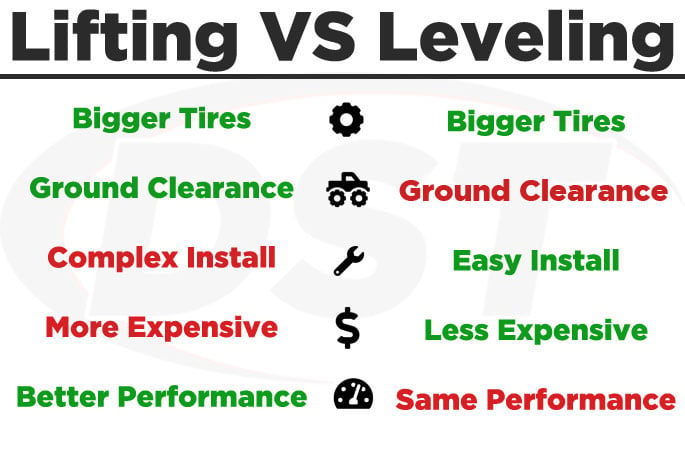When it comes to enhancing your vehicle’s off-road capability or elevating its stance for aesthetic appeal, the debate often boils down to two popular options: body lift kits and suspension lift kits. Each offers unique advantages, yet they cater to different needs and preferences. Understanding the nuances between a body lift and a suspension lift can be game-changing. It’s more than just about how high you’d like your truck to stand; it’s about harmonizing your vehicle’s functionality with your personal objectives.
Let’s begin by examining what each lift kit does. A body lift kit raises the body of the vehicle away from the chassis without altering the suspension components. Generally measured in inches, these kits allow for larger tires and provide a higher visual profile. However, the lift occurs without the manipulation of the suspension’s geometry, meaning the factory suspension setup remains intact. As a result, body lifts are usually more straightforward to install and can be less expensive than their suspension counterparts.
On the other hand, a suspension lift kit modifies the actual suspension system, altering the vehicle’s ride height while improving off-road capability. This kit changes the vehicle’s entire suspension architecture, allowing for enhanced articulation, better handling, and increased ground clearance. Unfortunately, this complexity often translates to greater costs and a more complicated installation process initially. But the rewards can be substantial when considering performance on rugged terrain.
So, which lift kit best suits your vehicle and driving lifestyle? Let’s dive deeper.
Understanding Your Intentions
Before you make a decision, it’s imperative to reflect on what you want to achieve. Are you primarily looking to improve aesthetics? Or is functionality your main concern? If your goal is simply to elevate your truck for cosmetic purposes, a body lift might suit your needs. It allows for a more aggressive look, letting you fit larger tires without affecting the ride quality.
However, if off-road performance is your focus, a suspension lift kit is the way to go. This option improves handling, ride quality, and ground clearance, making essential adjustments to your vehicle’s center of gravity and weight distribution. It opens doors to extreme terrains and addresses the mechanical limitations that a body lift cannot. In essence, your driving behavior should dictate your lift kit choice.
The Mechanics of Installation
However, a suspension lift kit demands a deeper dive into the mechanics of your vehicle. You often need to replace shocks and struts, and sometimes even require additional components like control arms or upper strut spacers. Because of this added complexity, hiring a professional to install a suspension lift is frequently recommended, although this does add to the overall cost of the modification.
Effects on Ride Quality and Handling
Another significant aspect to consider is how each lift kit affects ride quality and overall vehicle dynamics. Body lifts, while minimalistic in engineering, may not change the ride characteristics much. With the suspension remaining in its stock form, the original ride quality is retained, but your center of gravity will remain lower, which may affect performance in more demanding driving conditions.
Contrarily, a suspension lift kit can enhance the driving experience, making off-road excursions more enjoyable. With better articulation, suspension lifts allow the tires to stay in contact with the ground during challenging conditions, maximizing traction. Improved shock systems provide superior handling on both rough terrains and paved roads. However, some drivers report a slightly stiffer ride resulting from these upgrades, particularly when using higher performance shock absorbers.
Cost Considerations
Another integral factor in this decision-making equation is cost. Generally, body lift kits will weigh in lighter on your wallet. They are typically less expensive due to simpler installation and fewer components. Conversely, suspension lift kits can be pricier due to their comprehensive nature and the necessity for professional installation. However, consider this: investing in a suspension lift may pay dividends not just in performance but in long-term vehicle value and driving satisfaction.
Legal and Insurance Implications
In some jurisdictions, lifting a vehicle can affect compliance with safety and emissions regulations. While body lifts are less likely to invoke unnecessary scrutiny, substantial suspension modifications may warrant a re-assessment of your vehicle’s legal driving practices. Additionally, you should verify your insurance coverage—some providers may appreciate you disclosing modifications, particularly if they significantly alter the vehicle’s dynamics.
Conclusion: The Right Choice for You
Ultimately, the choice between a body lift and a suspension lift boils down to your personal needs, preferences, and intended use of your vehicle. Body lifts offer simplicity, cost-effectiveness, and aesthetic enhancement, whereas suspension lifts pack a punch in performance and off-road capabilities. Before making your decision, take a moment to assess your driving habits, project your vehicle’s future needs, and always aim to harmonize functionality with aesthetics. Whether you choose one or the other, effectively investing in your vehicle will ensure that it serves you well on any journey you undertake, whether on city streets or rugged paths.
